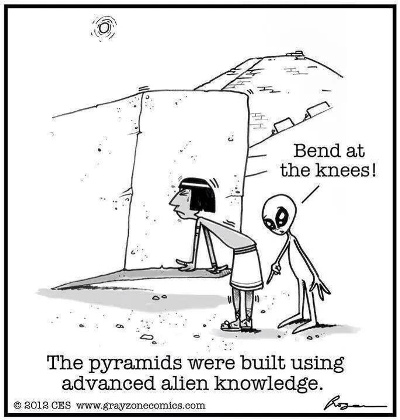| By: Paul S. Cilwa | Viewed: 7/27/2024 Posted: 10/14/2014 |
Page Views: 6889 | |
| Topics: #Science #UFOs #Transistors #Diodes #VacuumTubes | |||
| I uncover the mystery of who invented the transistor? | |||
When I joined the Navy back in the '70s, I was directed toward a "rating" (job) of Electronics Technician, which more or less describes the folks who repair radar and radio. Towards this end, I studied electronics at the Navy 'A' School in Great Lakes, Illinois; and, as I did so I discovered a rather odd mystery that took me decades to figure out. To appreciate this mystery, and its solution, one must have a rudimentary understanding of electronics. And I can give you enough of that, right here, right now. I promise it won't hurt.
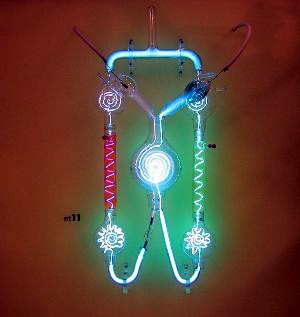
The story begins with a device called (in North America) a vacuum tube. (The Brits call it a "valve" instead of a "tube".) The first partially evacuated tube was invented in 1857 by German physicist and glassblower Heinrich Geissler. He experimented with different rare gases in the tubes; when an electric current was applied; the gases glowed in pretty colors. One of the gases used was neon; our neon signs evolved from Geissler's tubes.
Thomas Edison's signature electric light bulb, patented October 14, 1878—happy birthday, light bulb!—was one of the offshoots of Geissler's evacuated tubes.
Despite these experiments, the early 20th century was the tail end of the mechanical age. Player pianos, cameras, phonographs, sound recording and even the transmission of radio waves, were all accomplished by mechanical means. Even early telephones, while electrical devices, caught and recreated sound using mechanical methods and are considered electrical, not electronic, devices.
But experiments involving vacuum tubes continued, and in 1904 English physicist John Ambrose Fleming invented what he called an "oscillation valve", but which we today call a diode.
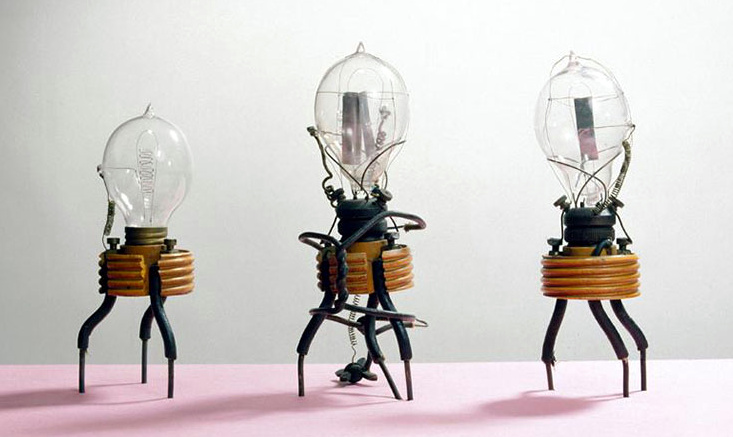
Electricity can be transmitted either as direct current, or alternating current. Direct current is what comes out of batteries and generators. Electrons are made to move from the battery's negative terminal to its positive terminal, usually passing through a device like a light bulb or motor on their way.
Alternating current moves back-and-forth, rather than in one direction only (and is created by an alternator). Some electrical devices, such as the light bulb, work equally well with either direct or alternating current. However, others firmly require one or the other. Clearly, then, a device that could convert one to the other, would be of great value. The diode only allows electricity to pass in one direction, thus converting alternating current into direct current.
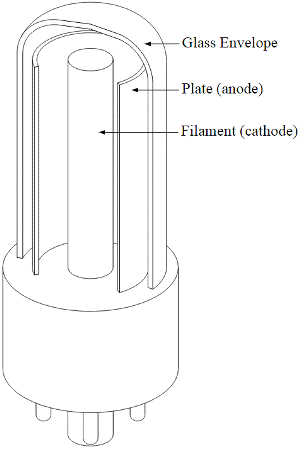
The way a diode works is quite simple—it was much harder to invent than it is to understand!
Inside the evacuated glass tube are just two components, called a cathode and and anode. The cathode is heated, causing electrons to boil off it when the current is on its positive swing. (The vacuum is required because if there were air in the tube, it would burn or explode from the heat. This was one of the reasons Edison's light bulb became a commercial success, whereas the 22 previous light bulb inventions from around the world, did not.) The anode sucks up the loose electrons. But when the alternating current changes directions, in other words the cathode becomes positive, its attraction for the electrons is too strong so they don't go anywhere. Thus, for the half time that the current is moving forward, the electrons go from the cathode to the anode; the other half of the time, nothing happens. The output, therefore, is a sort of "vibrating direct current" even though the input is alternating.
Within a few years, the diode had led to a truly amazing advancement: the triode. This device has three components in the tube: a cathode, an anode, and a grid. The anode and cathode work the same as in a diode, except the grid is provided with an additional input, which is generally a current of quickly-varying voltage (for example, the signal from a phonograph needle or a microphone). The grid therefore flips from positive to negative. Electrons pass from the cathode to the anode in direct proportion to the voltage on the grid. This allows the output current of the triode to be many, many times greater than the input. In other words, triodes amplify a signal and originally made possible all our modern electronic devices: radio, stereos, television, radar, computers, and so on.
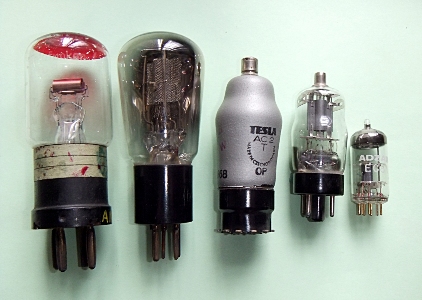
However: Vacuum tubes are big, and most devices required several of them, plus a lot of assorted wiring. The tubes got very hot, and died regularly. In the fifties, most families I knew kept a box of spare tubes to facilitate a quick replacement in case the radio or TV died in the middle of a show. If you didn't have such a box, you would have to run to Radio Shack for a replacement. (They also had tube testers, so you could figure out which tube had gone back and was keeping the device from working.)
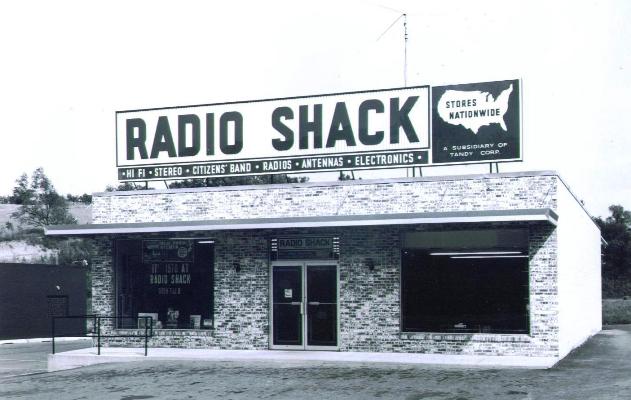
In the centuries since the English scientist William Gilbert made a careful study of electricity and magnetism, we have identified two distinct types of materials with regard to the way they conduct electricity. First, there are conductors, such as gold and copper, that allow the (nearly) free passage of electrons along their length and width. Second, there are insulators, such as glass and air, that provide (nearly) total blockage of free electrons.
In the 19th century, scientists began to catalog the properties of various materials, and found that some materials possessed some of the traits of conductors, combined with some traits of insulators. That is, they allowed the passage of some electricity, but less efficiently than pure conductors. On the other hand, when these "semiconductors" were heated, their electrical resistance decreased, the opposite of what happens when pure conductors are heated. Which seemed to be an interesting effect, but no one could find a use for it.
And that was the state of the art…until 1947.
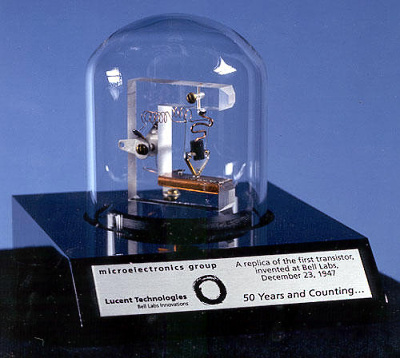
As I learned in my Navy 'A' School, in November and December of 1947, AT&T experimenters found that if two gold-point contacts were applied to a germanium crystal, the output signal was stronger than the input, making this a miniature triode, yet one that was far more efficient (not to mention, much smaller and cooler) than a vacuum tube.
At the time, AT&T was the telephone company, a government-sanctioned monopoly that, as part of its public charter, performed a great deal of cutting-edge scientific research.
Like triodes, transistors have three connections, each leading to the chip of semiconductor material—usually silicon "doped" with germanium. Like triodes, one lead is connected to an electric current, another to a varying voltage, and the output is a high-current flow of electrons that varies according to the voltage applied to the second lead, amplifying just as a triode does.
Once AT&T had patented a semiconductor diode as well, vacuum tubes became obsolete for most commercial purposes. (Vacuum tubes are still preferred for very high-frequency operations, such as television and radio broadcasting.) And transistors continued to shrink, finally being built right into slices of silicon by the billions, giving us pocket-sized cell phones, flash drives, and computers that fit in your pocket instead of taking up an an entire building.
But, wait…why did AT&T even consider such experiments? Semiconductors were not, in 1947, readily available. There was no theory to explain how they worked, or of what use they might be. They were simply something that existed in the natural world, like air or water. In any case, no one in the previous century had thought they were worth looking at.
And yet, AT&T's own records and history show that John Bardeen, Walter Brattain, and William Shockley of Bell Labs sat down in November, 1947 with nothing, apparently, to start with; yet had a working transistor triode a month or so later.
So I, in studying all this in the Navy, found myself wondering—what in the world could possibly have given Bardeen and Brattain the idea to work with germanium in the first place? There was simply no work on record to have provided them with a lead into this realm of study.
And I didn't have an explanation for years.
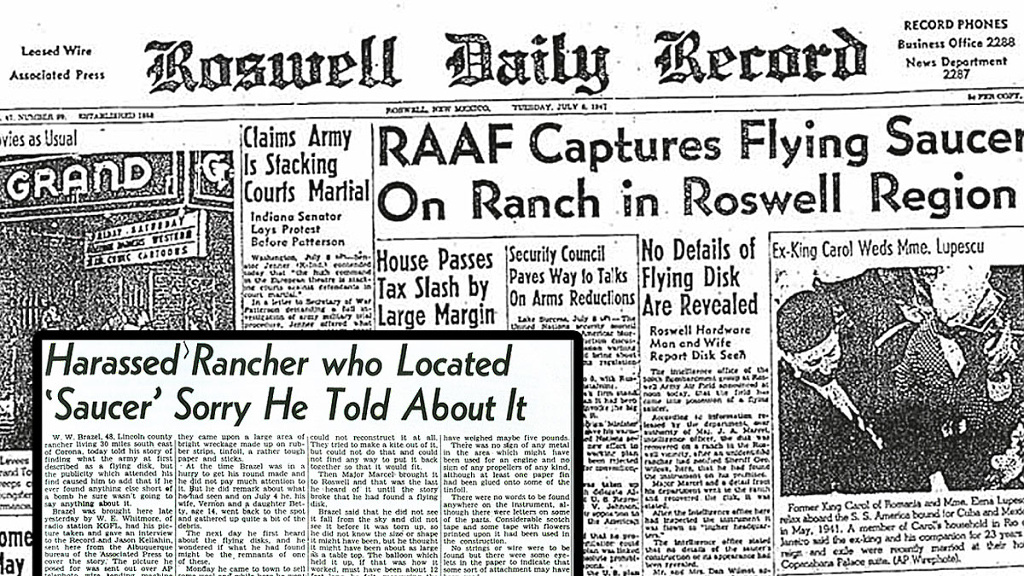
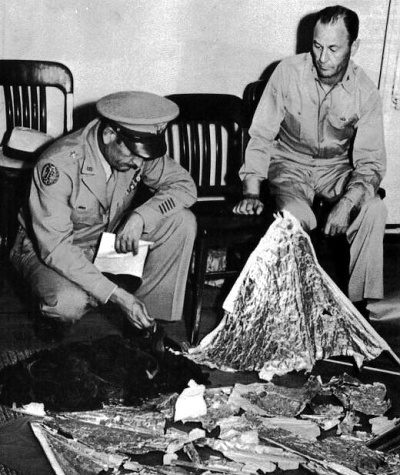
But then I learned about something else that happened earlier in 1947. Outside the little town of Roswell, New Mexico, on July 2, 1947, a "flying saucer" crashed. It was recovered by what, at the time, was the US Army Air Force, which, after announcing they had recovered a UFO, backpedaled and said it was just a weather balloon. They even published a photo of the balloon parts they had supposedly recovered, which experienced airmen pointed out were not from the type of balloon the Army Air Force had claimed, thus providing early proof that this was a cover-up.
And who could better reverse engineer alien technology, than America's foremost scientists, who, in those days mostly worked for AT&T?
Well, it turns out my notion was dead on. The Day After Roswell, a book written by United States Army Colonel Philip J. Corso, described how Corso was given the job of distributing the recovered technology to American corporations for reverse engineering. Without telling them where it came from, of course.
As you might expect, the naysayers were quick to claim fraud or a hoax. Senator Strom Thurmond, who knew Corso personally and had written the forward to the book, was pressured into demanding his forward be removed from subsequent printings of the book.
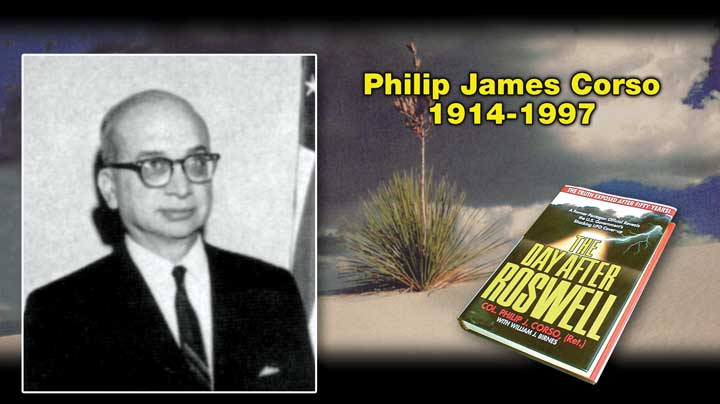
And yet Corso's stellar military career is a matter of public record. Every aspect of his story that should be a matter of public record, is. And the aspects one might expect to be hidden, nevertheless make sense in the grander scheme of things. Corso was not a scientist, and didn't really know what he was passing out. It was, perhaps, a matter of luck that AT&T wound up with the germanium-doped silicon so plentifully distributed in the walls of the downed craft.
Although Corso claimed to have distributed saucer components to only US corporations, Roswell was not the only crash site in 1947. Other UFOs have been reported downed here and there. And so we have Velcro, which was supposedly invented by a Swiss guy named George de Mestral. He claimed to have invented it in 1948 but did not patent it until 1955. Of course, even a child can examine some Velcro and figure how it works; it doesn't have the same "where did that come from?!" cachet that I find with transistors.
However…Mestral was an electrical engineer, and Velcro has nothing whatsoever to do with electrical engineering. So…I find myself wondering: What else that we think we invented, have we merely reverse engineered?
